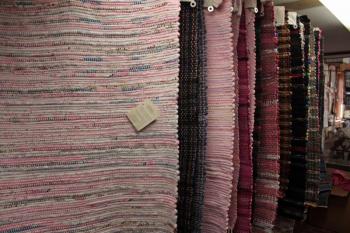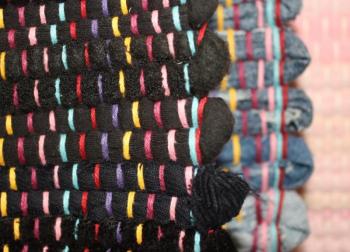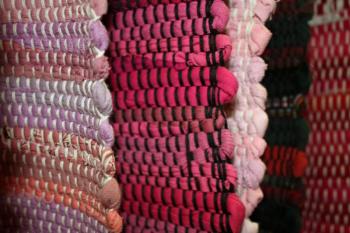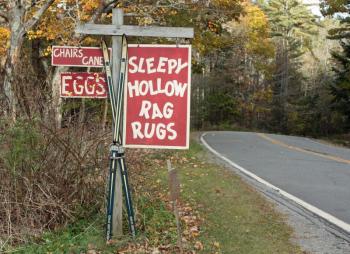Sleepy Hollow: Recyling and weaving rags, strips and scraps into unique works of art

For repeat customers of Diane and Wally O'Brien of Lincolnville, it's no mystery who the weaver of Sleepy Hollow Rag Rugs is. But for others, it's a surprise.
Since he retired from education in 1999, Wally has been the artist and craftsman to sit on the well-worn bench seat of their loom. He chooses the colors and the "patterns," if it can be said that there is a pattern to a true rag rug.
"I retired and as guys often do, I painted everything and did all the jobs guys often avoid doing over the years,” he said. “And then, the first day of hunting season that fall, I shot a deer across the road within the first hour.”
Basically, he immediately needed a new hobby. Diane knew just the thing.
The O'Briens had acquired their loom, which dates back to the early part of the 19th Century, from Union Historical Society in 1974.
The loom came in pieces, boxed and strapped in a bundle.
"We were assured all the pieces were there and they were," said Wally.
Old clothing, especially donated and free, is their material of choice. Diane said that weaving materials can be expensive, so to find a source of cloth from someone looking to recycle has made the rag rug business affordable for them. Wally said jeans are great, too, because if you think about it, they aren't dirty and stained on the inside, only the front.
"The appeals to me, the recycling aspect of what we are doing,” said Wally.
"And it also makes it more affordable," said Diane. "Because weaving is expensive, weaving materials are expensive, so to be able to find that free source of cloth has made it affordable for us.”
Wool, especially a kilt, is a great fabric to use, because it weaves faster than cotton and the patterns make beautiful rugs. But finding wool kilts is not as easy as it was 10 or 20 years ago. Cotton and cotton-like have been the favorite of rag rug makers.
Synthetics can't be used, because there are too slippery, and while they have made some rag rugs with upholstery fabric, it is usually too rough to work with, said Diane.
The year they got the loom, Diane was pregnant and could not fit her growing belly behind it to use it.
"Wally wanted me to have something to do, as I was staying home and not going back to work after having children," said Diane.
Her first child was 4 years old before Diane slid behind the loom. She taught herself how to use it and began weaving rugs around 1980.
"That's when I really got started selling rugs," she said.
Their loom weaves a maximum of 3 feet wide. The length is basically limitless, though practical manageability is a consideration. In the early days, Diane would take orders for rugs as large as 12 by 20 feet, which required weaving four 3-by-20 foot rugs and then sewing them together.
"I sewed it all together sitting on the floor. As I recall, it was was pale pink and for somebody on Islesboro," said Diane. "I hated doing those. I would lose more sleep doing those large rugs, so we stopped."
Now, they stick to rugs that fit their loom.
"If someone wants a larger rug, they can buy four of them and sew them themselves," said Diane.
Jump forward 19 years, and with her husband retired with honey-dos and house projects done, and fresh deer meat in the freezer, she decided to teach him how to weave rag rugs.
"I taught him, because I thought he should have something to do," said Diane.
Wally said that when his wife was the one weaving rugs, he would give her a hard time about certain colors she was using. That was especially true for a hot pink and charcoal gray version.
"It was a color guys used to wear in the 1950s and I remember it being the damnedest thing I had ever seen. Those outfits back then... it was terrible and I used to say to her, 'Why don't you take that apart; nobody is going to buy that rug.’”
But she didn't. She left it hanging up for sale and he learned she was right. A couple of years after Wally took up the weaving, two men from western New York stopped in to Sleepy Hollow and were looking to decorate their apartment in 50s style.
"There it was, and they thought it was the most beautiful rug they ever saw," said Wally.
That moment, he said, gave him a lot of flexibility and freedom to stretch his own wings with color combinations. But then, the tables turned. It was Diane's turn to critique Wally's color choices.
And at one point, he was weaving rugs using the colors that harken back to old black velvet paintings sold in filling stations.
"I did a bunch of rugs in those colors, hot-hot greens and pinks and stuff like that,” he said. “I had $700-$800 worth and Diane was giving me such a hard time, saying nobody would buy them. “And then this woman came in, looking like she was from Greenwich, Conn., blond and well dressed, and I totally miscast her. She loved the rugs and bought every single one and I thought, geez, I can make anything I want and someone is going to come along and want them."
Diane and Wally said that has grown to become their theory, their mantra. Just like the movie with its iconic line: "Build it and they will come" the O'Brien's line is: "Weave it and someone will eventually come... and buy it."
Wally said he really enjoys playing with colors, and trying things that someone like a painter would never think to try, let alone pull off.
When I first started, I would pick fabric with a lot of colors in it. And then I would supplement. But then you get to point where you really don't care," said Wally. "It's not like painting,where you have to have balance and symmetry to it. With a rug, I can put oranges and reds together and maybe pink, too, and they look great. Try that with a painting and my God, people would be horrified."
The O'Briens have been married for 36 years, and they have lived in the same house at 217 Beach Road for as many years. Their thoughts on being happy for all is one for the books.
"One thing I should say is, if you want to stay married to someone, don't do the same things," said Wally. "You notice Diane now does the lewelry and the knit hats and scarves, she does not do rag rugs. It's a wise thing."
"I haven't woven a rug in years," added Diane.
Reach Editorial Director Holly S. Edwards at hollyedwards@penbaypilot.com and 207-706-6655.












































